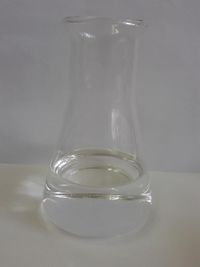Tetrahydrofuran
 Freshly distilled THF
| |
| Names | |
|---|---|
| IUPAC name
Tetrahydrofuran
| |
| Preferred IUPAC name
Oxolane | |
| Other names
1,4-Epoxybutane
Butylene oxide Cyclotetramethylene oxide Diethylene oxide Furanidine Oxacyclopentane Tetrahydro-furan Tetra-methylene oxide THF | |
| Properties | |
| C4H8O | |
| Molar mass | 72.11 g/mol |
| Appearance | Colorless liquid |
| Odor | Ether-like |
| Density | 0.8892 g/cm3 (20 °C) |
| Melting point | −108.4 °C (−163.1 °F; 164.8 K) |
| Boiling point | 66 °C (151 °F; 339 K) |
| Miscible | |
| Solubility | Miscible with acetone, diethyl ether, ethanol |
| Vapor pressure | 132 mmHg (20 °C) |
| Thermochemistry | |
| Hazards | |
| Safety data sheet | Sigma-Aldrich |
| Flash point | −14 °C |
| Lethal dose or concentration (LD, LC): | |
| LD50 (Median dose)
|
1650 mg/kg (rat, oral) 2300 mg/kg (mouse, oral) 2300 mg/kg (guinea pig, oral) |
| LC50 (Median concentration)
|
21000 ppm (rat, 3 hr) |
| Related compounds | |
| Related compounds
|
Diethyl ether Furan |
| Except where otherwise noted, data are given for materials in their standard state (at 25 °C [77 °F], 100 kPa). | |
| Infobox references | |
Tetrahydrofuran or simply THF is an organic compound used as a solvent in chemistry. It is a heterocyclic compound, specifically a cyclic ether, or furan, with the formula (CH2)4O.
Contents
Properties
Chemical
THF will dissolve most plastics. In the presence of strong acids, THF converts to a linear polymer called poly(tetramethylene ether) glycol (PTMEG), used in the production of Spandex.
- n C4H8O → -(CH2CH2CH2CH2O)n-
THF can be produced by acid-catalyzed dehydration of 1,4-butanediol.
THF forms adduct complexes with lithium, magnesium, and boranes.[2]
Physical
THF is a clear, colorless, water-miscible polar organic liquid with low viscosity. Its odor is sometimes described as between acetone and diethyl ether. THF has a melting point of −108.4 °C and boils at 66 °C. It has a density of 0.8892 g/cm3 at standard conditions.
Availability
THF is very hard to find, as most chemical suppliers will charge various hazard fees for it. In some countries it's a controlled substance because of its use in synthesizing GHB; for example, in Russia, it's a FSKN List IV chemical.
Certain PVC glues contain a mixture of THF and cyclohexanone. Other PVC glues also have methyl ethyl ketone as a third component. Distillation is required to extract the solvents from the PVC glue, while fractional distillation can be used to purify it.
Preparation
THF is difficult to synthesize by the amateur chemist. Industrially is made via acid-catalyzed dehydration of 1,4-butanediol, the latter being classified as a controlled substance in certain countries and US states.
One method discussed involves the cyclization of n-butanol, via two ways: in benzene at 80°C or irradiated with UV light at room temperature, both in the presence of lead(IV) acetate. The lead(IV) acetate is reduced to lead(II) acetate, so it needs to be replaced as well. Instead of Pb(OAc)4, a mixture of halogen (Br2 or I2) and an oxide or salt of silver or mercury, such as silver acetate or mercury(II) oxide can also be used[3]
Other methods involve catalytic hydrogenation of furan or conversion of pentose. Similar methods can also be used to produce the less polar ether 2-methyltetrahydrofuran.
Projects
- Organometallic syntheses
- Stabilizing chromium(II) and samarium(II) compounds
- Organic extractions
Handling
Safety
THF is considered a relatively nontoxic solvent, with the median lethal dose close to that for acetone. However it is a strong irritant and penetrates the skin quickly, causing rapid dehydration. THF readily dissolves latex, so nitrile or neoprene gloves are required for handling the the solvent. It will also attack and soften most plastics.
Storage
Just like the other ethers, THF will form explosive peroxides when stored in air, so must never be distilled to dryness. Butylated hydroxytoluene (BHT) is usually added to limit the peroxide formation. Sodium hydroxide pellets are usually added to precipitate the resulting peroxides.
THF is hygroscopic, so it's recommended to be dried before use. Molecular sieves are good for drying, as well as distillation.
Disposal
THF can be safely burned, although this is not recommended if the solution is very old. THF must never be poured down the drain.
References
- ↑ Cass et al.; Journal of the Chemical Society; (1958); p. 1406,1407
- ↑ http://en.wikipedia.org/wiki/Adduct
- ↑ March's Advanced Organic Chemistry: Reactions, Mechanisms, and Structure; Michael B. Smith, Jerry March, p. 965-966